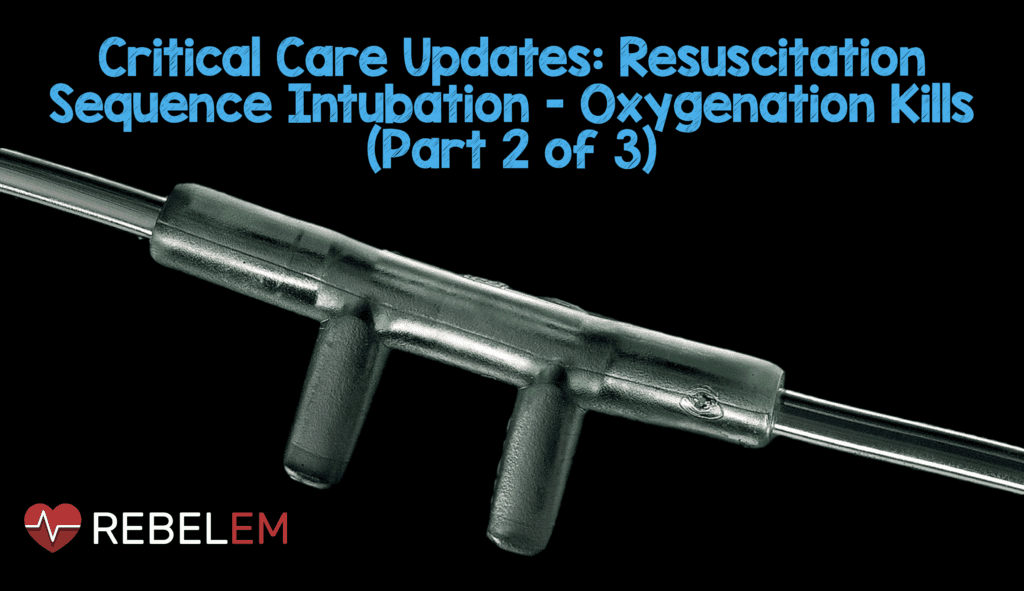
 This blog post is the second part of a series of 3, on a recent lecture I was asked to give on Critical Care Updates: Resuscitation Sequence Intubation. This talk was mostly derived from a podcast by Scott Weingart (Twitter: @EMCrit) where he talked about the physiologic killers during preintubation and perintubation. In this podcast, Scott mentions the HOp killers: Hypotension, Hypoxemia, and Metabolic Acidosis (pH) as the physiologic causes of pre-intubation/peri-intubation morbidity and mortality. Taking care of these critically ill patients that require intubation can be a high stress situation, with little room for error. In part two of this series we will discuss some useful strategies at the bedside to help us reduce pre-intubation/peri-intubation hypoxemia.
This blog post is the second part of a series of 3, on a recent lecture I was asked to give on Critical Care Updates: Resuscitation Sequence Intubation. This talk was mostly derived from a podcast by Scott Weingart (Twitter: @EMCrit) where he talked about the physiologic killers during preintubation and perintubation. In this podcast, Scott mentions the HOp killers: Hypotension, Hypoxemia, and Metabolic Acidosis (pH) as the physiologic causes of pre-intubation/peri-intubation morbidity and mortality. Taking care of these critically ill patients that require intubation can be a high stress situation, with little room for error. In part two of this series we will discuss some useful strategies at the bedside to help us reduce pre-intubation/peri-intubation hypoxemia.
What was the Premise of this Talk?
- Resuscitate Before You Intubate
- Hefner AC et al [1] and Kim WY et al [2] evaluated over 2800 patients requiring emergency intubation. In both trials the rate of cardiac arrest (CA) within 10 minutes of intubation ranged from 1.7% – 2.4%. Both trials listed pre-intubation hypotension (SBP ≤90mmHg) as a risk factor for cardiac arrest. Hefner AC et al also mentioned hypoxemia as a risk factor as well.
What are the Physiologic Killers Pre-intubation/Peri-intubation?
-
HOp Killers (Credit to Scott Weingart at emcrit.org)
- Hypotension (Hypotension Kills – Part 1 of 3)
- Hypoxemia
- Metabolic Acidosis (pH) (pH Kills – Part 3 of 3)
Hypoxemia Kills
-
The Basics:
- Think NO DESAT (Nasal Oxygen During Efforts Securing A Tube)
- NC at 15LPM + NRB at 15LPM (In all actuality you are turing the O2 all the way up, which may be more than 15LPM)
- If you cannot get the O2 Saturation ≥95%, then consider the following:
- Lung Shunt Physiology (i.e. Pulmonary Edema, Pneumonia, etc…). These patients still need oxygen, but also need PEEP to recruit atelectatic alveoli to overcome the shunt
-
Intervention 1: NC 15LPM + BVM 15LPM + PEEP Valve 5 – 15cmH20
- You don’t need to bag these patients, they need a tight seal and jaw thrust (i.e. Apneic CPAP Recruitment)
- Bottom Line: In critically ill patients in which you cannot get O2 Sats ≥95%, consider shunt physiology and use Apneic CPAP Recruitment
-
Intervention 2: Delayed Sequence Intubation (DSI)
- Procedural sedation for the procedure of preoxygenation
- Give 1mg/kg IV Ketamine -> Preoxygenate -> Paralyze the Patient -> Apneic Oxygenation -> Intubate
- Evidence: Weingart et al Ann Emerg Med 2015 [1]
- Observational trial with >150 intubations -> 62 patients uncooperative/combative
- Mean O2 Saturation increased from 89.9% unto 98.8%
- No Complications
- Bottom Line: In critically ill, agitated patients, who are hypoxemic, that need to be intubated, consider using DSI, which is procedural sedation for preoxygenation.
- Procedural sedation for the procedure of preoxygenation
-
Intervention 3: Back Up Head Elevated (BUHE) Intubation [2]
- 528 Intubations
- Primary Outcome: Composite of Any Intubation-Related Complication (Difficult Intubation ≥3 Attempts or > 10 min, Hypoxemia <90% O2 Sat, Esophageal Intubation, or Esophageal Aspiration
- Primary Outcome Results:
- Standard Supine Intubation: 22.6%
- BUHE Intubation 9.3%
- Bottom Line: BUHE still needs prospective external validation in an ED setting, but seems to decrease intubation-related complications in comparison to standard supine intubation
Clinical Bottom Line:
- Pre-Intubation Hypoxemia is a risk factor for Peri-Intubation Cardiac Arrest:
Options to Improve Hypoxemia: - Start with NO DESAT (Nasal Oxygen During Efforts Securing A Tube) at 15LPM + NRB at 15LPM
- If you don’t get the O2 Sats ≥ 95% think about shunt physiology and consider the following interventions:
- Intervention 1: NC 15LPM + BVM 15LPM + PEEP Valve 5 – 15cmH20 (Apneic CPAP Recruitment)
- Intervention 2: Delayed Sequence Intubation (DSI)
- Intervention 3: Back Up Head Elevated (BUHE) Intubation
- Many of these interventions can be done simultaneously to ensure no hypoxemia
Credit to Scott Weingart (Twitter: @EMCrit) for creating the HOp Killers mnemonic.
For More Thoughts on This Topic Checkout:
- Scott Weingart at EMCrit: Delayed Sequence Intubation
- Scott Weingart at EMCrit: Preoxygenation, Deoxygenation, and Deoxygenation
- Scott Weingart at EMCrit: Apneic CPAP Recruitment Demonstration by George Kovacs
- Ben Cleary at CORE EM: Bed-Up-Head-Elevated Position for Emergent Intubation
References:
- Weingart SD et al. Delayed Sequence Intubation: A Prospective Observational Study. Ann Emerg Med 2015; 65(4): 349 – 55. PMID: 25447559
- Khandelwal N et al. Head-Elevated Patient Positioning Decreases Complications of Emergent Tracheal Intubation in the Ward and Intensive Care Unit. Anesth Analg 2016; 122(4): 1101 – 7. PMID: 26866753
- Mosier JM et al. The Physiologically Difficult Airway. WJEM 2015; 16(7): 1109 – 17. PMID: 26759664
Post Peer Reviewed By: Anand Swaminathan (Twitter: @EMSwami)
The post Critical Care Updates: Resuscitation Sequence Intubation – Hypoxemia Kills (Part 2 of 3) appeared first on REBEL EM - Emergency Medicine Blog.
